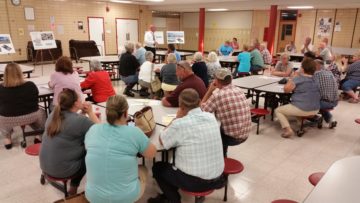By JAN LARSON McLAUGHLIN
BG Independent News
Bowling Green Superintendent Francis Scruci faced a tough crowd Monday evening – members of the local farming community, looking for information on the school district’s 6-mill bond request for buildings.
The bond issue could be a hard sell to farmers, since owners of large amounts of acreage will be among those most affected by the property tax on the November ballot. This was the third time the superintendent has met with members of the farming community. And each time he has not pushed for them to pass the bond issue.
Instead, Scruci has suggested they ask themselves two questions.
“Does this help move the community forward and is it good for kids?”
Then came the tougher one. “Can you afford it?”
“We know there are people in this community who can’t afford it,” Scruci said. And they have to cast their votes accordingly. That doesn’t mean they are against the school district or the students, he added.
But the district cannot wait until everyone in the district can afford new schools, he said.
“This community will never grow and our kids will not get what kids in every other district in our area are getting,” Scruci said.
The superintendent fielded questions about why the district can’t use an income tax, which wouldn’t hurt local farmers as much. An income tax cannot be used to pay for a building project, he explained.
What about an increase in sales tax, someone asked. The schools have no way to increase sales tax, Scruci said.
One man said the length of the bond issue – 37 years – poses a problem for smaller farmers.
“Can we sustain it, with our current income? It’s highly unlikely,” the farmer said.
Another farmer questioned why BGSU students, who are temporary residents in Bowling Green with no property tax responsibilities, would be allowed to vote on the school bond issue.
“College kids are allowed to vote on it? That ain’t right,” he said.
“There’s a lot of problems with the way schools are funded,” Scruci said.
One woman in the crowd thanked Scruci for being transparent. “I don’t feel like you’re trying to trick us,” she said.
Scruci also explained why Bowling Green was not using state help on the project. The state formula for aiding building projects ranks Bowling Green as an affluent district based on the number of residents and the size of the district. However, the formula fails to take into account the number of college students and the amount of farmland, Scruci said.
Consequently, the state would only give Bowling Green 12 percent of the building costs. That compares to 80 percent for Elmwood and 55 percent for Otsego. Once the state gets involved, it takes over the project, Scruci said.
“It’s not worth it,” for 12 percent, he said.

Meeting about school bond issue Monday evening.
Monday evening’s meeting was held in the high school cafeteria, which was very toasty and had some audience members fanning themselves with the bond issue brochures.
“This isn’t about air conditioning,” Scruci said about the building projects. The driving force is academics, he said. “We have academic spaces that don’t meet today’s needs.”
The current buildings are too small and can’t provide for today’s technology, he said. “Education has changed.”
An evaluation of the elementaries showed Kenwood and Conneaut were not worth the amount it would take to renovate them. “The bones of these buildings were not sufficient to renovate,” he said.
So the board decided to build one centralized elementary school, and renovate plus add onto the high school. The high school’s square footage will increase 33 percent. The total cost for the buildings is estimated at $71.9 million.
The centralized elementary, which would sit north of the middle school, would provide for collaborative learning spaces, an equity of resources, and would even up class sizes, Scruci said. He explained that currently the kindergarten classes at Conneaut and Crim have the maximum of 24 students, while Kenwood kindergarten classes have 16 students each.
The elementary would be built to support technology, and would have adequate room. No modular units would be needed, as are currently being used at Conneaut. And the music teacher will no longer have to teach in the old shower room, which is also occurring at Conneaut, he said.
The elementary would be divided into wings, with one for kindergarten and first grade, another for second and third, and one for fourth and fifth grades.
The building plans would allow the district to realize savings in several areas such as:
- $50,000 a year that would not have to be spent on renting central administration space, since that would be shifted over to the Crim building.
- Nearly $1 million a year that the district pays to other locations since it has no space now for programs for children with autism or other special needs.
- $100,000 a year that will no longer be needed for shuttle buses between the three elementaries.
- $100,000 a year for transportation to St. John’s and Toledo School for the Arts, since they are actually over the distance limit requiring BG to pay.
- $4,000 to $7,000 a year that the district currently spends for graduation at the BGSU Stroh Center. The new gym area would be large enough to hold graduation, and to host regional sports tournaments which could bring in revenue for the district.
- $5,000 a year that would not be used to lease space for preschool, since Crim would have room for an expanded preschool.
- No need to continue renting modular classrooms at Conneaut.
- Estimated 30 percent savings on energy costs.
- Efforts to see if local businesses will sponsor certain classrooms, and help with costs.
“We’re trying to find every way to save money,” Scruci said.
There is money in the proposal to demolish Conneaut and Kenwood elementaries.
“We’re not going to leave a South Main or a Milton standing and devaluing the neighborhood,” Scruci said. “We’re going to be good neighbors.”
One of the farmers at Monday’s meeting asked about the emphasis placed on larger athletic facilities, while the FFA will lose its cornfields north of the school complex for the new centralized elementary.
Scruci said he also values the FFA, and he is trying to find another three acres that can be farmed by the agricultural students.
The superintendent explained that with the current athletic facilities, some students don’t get home till 10 p.m. on school nights, since 10 different teams have to share limited facilities during some seasons.
The superintendent also broke the expected news that the district will likely go back to the voters in 2020 or 2021 with an operating levy request.
“I’m not going to stand here and tell you we are not going to come back for operating funds,” he said. But that levy could be an income tax, rather than another property tax, he added.
If the bond issue for the buildings fails this November, Scruci said the district will be back with the same issue next year. It will not go for a revised, less costly plan.
“This is the right thing for kids, for teachers, for the community of Bowling Green,” he said.





